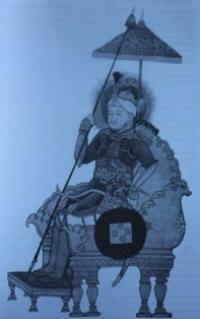Вы здесь
Engravings of Gur-Emir

Architectural tours over Samarkand.
“It was up this causeway that the Tajik ancestors, the Sogdians, had fled from Arab invaders in the eighth century. For more than fifteen hundred years they had lived along the Zerafshan in a loose-linked galaxy of oasis princedoms. Rut Turkic and Arab incursions at last confined them to the great cities, where their Tajik descendants survive, or drove them deep into the mountains, and the valley which we followed still seemed to echo their desperate migration”
The Lost Heart of Asia, Colin Thubron.
Familiarization tour in Samarkand.
Initially the mausoleum was built only for the beloved grandson of Timur, Muhammad Sultan, who died young in 1403. But history decreed otherwise. Just three years after her grandson was followed by the Great Timur: during the Chinese campaign he contracted pneumonia and died.
Then, in the burial place of their last refuge famous as the great medieval astronomer Ulugbek and other rulers – the descendants of Timur – Timuridi. In June 1941 by the decision of the government of Uzbekistan, scientists - archeologists opened the tomb of Gur-Emir.
Excavations have confirmed that the mausoleum is indeed buried Timur, Ulugbek, Shakhrukh, Miranshah and Mohammed Sultan. Anthropologist - restorer M. M. Gerasimov has reconstructed the skulls sculptural portraits of Tamerlane.
The remains of Temur and Muhammad Sultan were in wooden coffins, all the other burials directly in the sarcophagi. The tomb of Timur made of arched wood. The bodies were embalmed.
Burial of the ruler-astronomer Ulugbek confirmed the version of the historians that he was murdered and buried as a Martyr in the clothes in which it was found by a death that is fully consistent with the requirement of Shariah.
"They all float, each to its assigned term," the lines from the notes to the inscription on the tombstone of a scientist. The Majesty and lightness of architectural lines and shapes, richness of colorful mosaic, monumentality and harmony of proportions, painted decorative coating of interior made the Gur-Emir mausoleum a unique monument of Central Asian architecture.
This ensemble, including madrasah, khanaka was merged square four - aivans courtyard with high walls, four corner minarets and portal. The portal is decorated in the technique of carved inlaid mosaic.
Striking a delicate beauty of the patterns made by the craftsman Muhammad Ibn Mahmud Isfahani. Restoration work was carried out in 60-ies of XX century, and 90-ies. Restored to the height of human growth the walls of the courtyard, raised several rows of masonry walls of the cells of the madrasah.
During the restoration works from photographs and dimensioned drawings made in the nineteenth century, in 1996 to 660 anniversary of Amir Timur Sokhibkiron, restored the two minarets.
The composition of the Gur-Emir mausoleum is designed in the circuit that has become traditional in Maveranahre: prism base, the cylindrical drum of the dome. But there are also innovations: prism base - octagonal, unusual for monumental architecture of Central Asia, the unique shape of the outer dome is topped with a gold finial - Kubba.
The height of the dome 12.5 meters, diameter at base is 15 m. However, the dome does not seem so bulky. This is achieved due to the fact that it is divided into facets, which fades to the drum.
Turquoise watering gives it a particularly elegant look on the background of bright blue sky of Samarkand.
Authority:
«Religious and spiritual monuments of the Central Asia». The author of M. Khashimov. Publishing house "Saga", 2001. The collection «Architectural and archeologic monuments of Uzbekistan», "Saga:, 2003. «Samarkand. The directory-guidebook Authors I.Umnyakov, Yu.Alekserov. Arapov A.V. Samarkand "Masterpieces of the Central Asia". Publishing house «Mass-media-ASIA San’at» 2008. Arapov A.V. «Samarkand. The guidebook "Publishing house mass-media-ASIA San’at» 2007.







